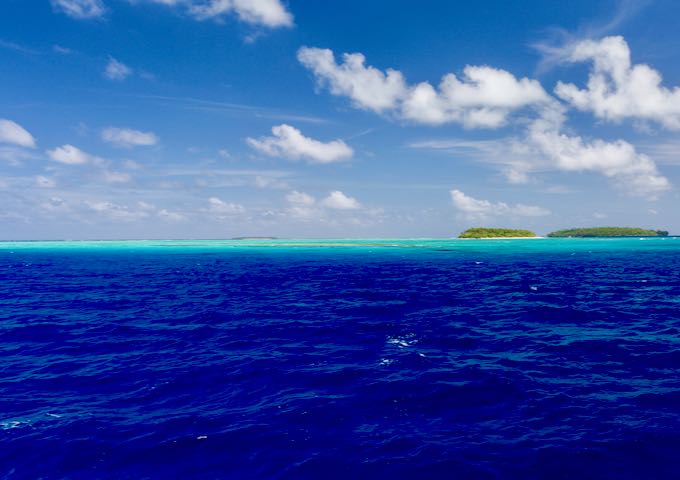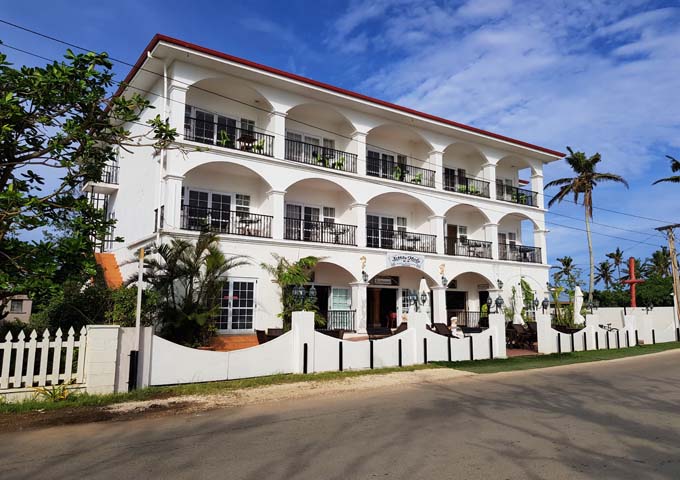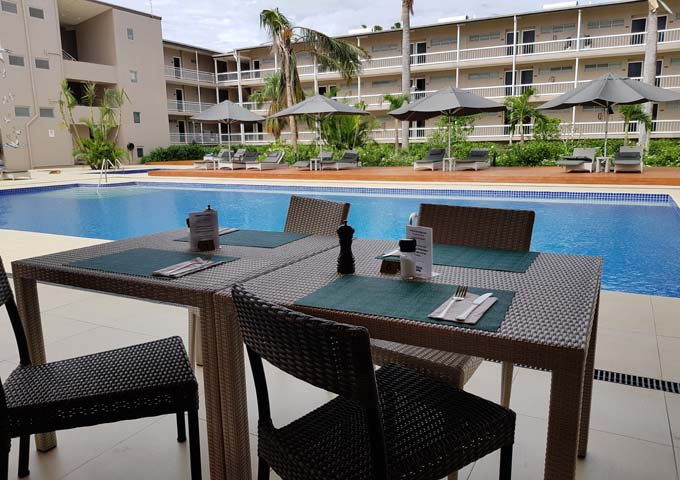SD › Tonga Best Places
Updated: September 15, 2020
By Santorini Dave
The Best Places to Stay in Tonga

Best Place for Diving & Snorkelling in Tonga: Vava’u Islands
The forgotten little sister of Polynesia, Tonga suffers from a lack of identity, under-population (only about 110,000), and a dearth of international connections. The South Pacific’s only kingdom is not on the tourist trail, unlike Fiji, which is more accessible; New Caledonia, which is considerably more developed; and Vanuatu, which is larger and with much more to offer. And Tonga is comparatively disorganized: e.g. there is no scheduled public transport anywhere (even in the capital), taxis are unmetered, and the only international airport at Fua’amotu resembles a hut (but was being renovated in 2018).
Tonga still offers the same sort of attractions as the other islands – snorkeling among turquoise lagoons, and lazing on distant snow-white beaches – but there are very few travel agencies to organize anything this sedate, let alone something more adventurous. Some visitors relish the authenticity of the ‘real’ Polynesia, the paucity of tourists, and the chance to easily get off the beaten track. Others despair about the unkempt beaches, unreliable inter-island transport, occasional shortages of basic foods, and the virtual closure of the entire country every Sunday.
About 75% of Tongans live on the main island, Tongatapu, with a third of these residing in Nuku’alofa (which means ‘Abode of Love’). The laid back capital is likeably shabby and surprisingly undersized, with a couple of mildly interesting attractions, and an apparent oversupply of hotels. The only beach on the island is the stretch between Ha’atafu and Kanokupolu on the far western tip, which offers winds adored by surfers, and lagoons relished by snorkelers.
Most of the remaining 170 islets and atolls are uninhabitable and inaccessible by plane or boat, but ideal for well-equipped yachties. All offer pristine beaches and luminous lagoons, but a few also have other attractions. ‘Eua, close to the main island, has a national park, with mountains, caves and rainforests perfect for trekking and bird-watching. The Ha’apai Islands, dotted with tiny villages and uninhabited islets, offer numerous activities (such as horse-riding), and some colonial buildings and archaeological remains to explore. And the far-flung Vava’u Islands are a yachting haven offering history, charm and adventure.
But remember: Tonga is one of the least developed island countries in the South Pacific. Inter-island flights are infrequent and expensive; boat travel is long, uncomfortable, and occasionally, unsafe; and facilities such as banks and chemists are non-existent outside the capital.
The Best Places to Stay in Tonga
- Best Luxury Hotels in Tonga
Waterfront Lodge • Tanoa International Dateline Hotel • Mystic Sands - Best Boutique Hotels in Tonga
Little Italy Hotel • Seaview Lodge - Best Budget Hotels in Tonga
Emerald Hotel • Tungi Colonnade Hotel

Little Italy Hotel in Nuku’alofa, Tonga.
- Best Region for Beaches: Uoleva Island
In a tropical archipelago of islands encircled by bleached-white sand and turquoise-blue waters, it seems unfair to narrow down just 1, but Uoleva wins by a whisker. Part of the Ha’apai group of islands, the beaches are not only pristine and mostly empty, but perfectly photogenic: curved bays of sloping palms with coral and marine life almost within touching distance. Except for hotel staff and guests, the island is uninhabited, so it’s the quintessential ‘tropical island escape’, yet Uoleva is just a short boat ride from the main island, with the ferry terminal and airport. And the migrating humpback whales come close to shore between July and October. - Best Region for Diving & Snorkelling: Vava’u Islands
Tonga boasts an extraordinary assortment of marine life, including turtles, manta rays, marlin, and even (harmless) sharks. Add underwater caves, volcanic tunnels, coral gardens, and clear blue waters, and it’s no surprise that divers relish the region. The Vava’u Islands to the distant northeast also offer crystal-clear waters, soft and hard coral, severe drop-offs, amazing visibility (often over 30m), and unusually for the region, a shipwreck. Snorkeling is also ideal in the calm lagoons just offshore. Getting there is not easy, but leaving may be even harder. - Best Region for Surfing and Water Sports: Ha’atafu Beach
The finest surfing spot in Tonga is pleasingly accessible – only about 22km from the capital. Alongside the Ha’atafu Marine Reserve, the beach is perched at the top of the Hihifo Peninsula, which receives winds and swells from 2 directions, so surfing is top-notch all year: but for experts only. Surprisingly, Ha’atafu, and the beach which extends to Kanokupolu, also faces an extensive lagoon that has ensnared abundant marine life, so it’s ideal for snorkeling, swimming, and kayaking. But note: unlike Fiji, water-sports such as jet skiing and paragliding are not offered anywhere in Tonga. - Best Region for Boating: Neiafu (Vava’u Islands)
There are 3 things that yachties strive for: steady and reliable winds, which Tonga offers all over, especially in the north; a sheltered harbor for mooring; and plenty of après-sailing facilities, particularly bars and cafés. In Neiafu, the wonderfully-named Port Of Refuge is regarded as one of the safest and most scenic harbors in the South Pacific, and offers some colonial history and appealing eateries. - Best Region for Shopping: Nuku’alofa
The capital of barely 25,000 people is really just an overgrown village, so markets are still an integral part of community life, if only because there are no western-style supermarkets in the entire country. With no internationally-known outlets, or anything remotely resembling a mall, the Talamahu Market offers a wide range of fresh produce and meat, and a handful of souvenir stalls, while impromptu fish markets are set up on boats along the harbor facing the eastern esplanade. Perhaps more of interest is the Langafonua Handicrafts Centre along the main street, with an impressive range of locally-made arts and crafts at reasonable set prices. - Best Region for Food & Restaurants: Neiafu (Vava’u Islands)
Every resort and major hotel has at least 1 restaurant – even in the more remote islands, where there may be nowhere else to eat anyway. The capital is disappointing, with only a sprinkling of decent cafés, while most eateries there sell nothing but deep-fried junk. The finest range and quality of food and restaurants is where the money is: Neifa, one of the world’s most scenic ports for yachties who stay for weeks, often longer. The photogenic Port of Refuge is lined with expensive boats, and therefore, cafés and bars, all popular for waiting, recovering, and networking. Think gin and tonics on deckchairs along terraces above the harbor, and exclusive yacht clubs with pricey European cuisine. Of course, the seafood is abundant and fresh. - Best Region for Families: Tongatapu Island
In stark contrast to neighboring island countries, Tonga offers very few resorts catering for families, e.g. with special rooms, packaged deals, kids’ clubs, or children’s pools, and there is nothing remotely like an adventure park. To avoid traveling to remote islands, which involves expensive flights and (often) extended waits at airports, some families stay on the main island of Tongatapu. The number of attractions in the surprisingly undersized capital, Nuku’alofa, is very limited, but it’s spacious and safe, with minimal traffic, and boat trips to the nearby islands of Fafá, Pangaimotu, and ‘Atata are easy to arrange. The only beaches on Tongatapu – at Ha’atafu and nearby Kanokupolu – are easy day trips from the capital, but the younger ones may prefer staying there in a rustic bungalow facing a Crusoe-like beach, with a perfect lagoon for swimming, kayaking, and snorkeling. - Best Region for Vibe & Culture: Nuku’alofa
With only about 25,000 people (which still equates to about one-quarter of the country’s population), the capital is still a village at heart. To experience the traditional way of life, set firmly on Tonga Time, visit the expansive Talamahu Market, which operates in lieu of any sizeable supermarket in the entire country. The other community hubs are the numerous churches, some modern and evangelical, others colonial and traditional. Churches are always packed on Sundays (when the entire country virtually closes), but there’s always room for visitors. Nuku’alofa is also home to the Royal Family, with the palace and tombs in the town center, but these are off-limits to all. - Best Region for Weather: ‘Eua Island
Only a few degrees south of the equator, there’s no escape from the tropical climate, although Tonga is milder overall than, say Bali or Phuket. During the wet season (November to April), the high temperatures and humidity are not as problematic as the incessant rain and looming cyclones. In contrast to the northern islands of Vava’u, which are hotter and stickier for longer, the most southerly island of ‘Eua is the driest and coolest part of Tonga. Also, the mountains affect the climate, keeping the humidity at bay, and ensuring chilly nights that occasionally necessitate a jumper. - Best Region for Romantic Holidays: Fafá Island
Unlike other South Pacific countries, Tonga hasn’t embraced the booming honeymoon market, so almost no resort offers intimate villas with plunge pools, or secluded over-the-water bungalows. One exception is Fafá Island Resort, a private island barely 30 minutes by boat from the capital. Fronting a superlative beach, it offers a limited number of gorgeous traditional-style fales (bungalows): 2 especially for newlyweds. Guests can be romancing within an hour or so of landing in Tonga, although total seclusion could be blighted by pesky day-trippers.
The Best Regions in Tonga for Tourists

The Tanoa International Dateline Hotel in Nuku’alofa.
Nuku’alofa (on the main island)
The undersized and underwhelming capital offers a decent range of cafés, and budget and mid-range accommodation, but only 1 place could be called a resort. There is little in town to keep visitors occupied, other than a market or 2, and a church or 6, and the coastline is pleasant for walking, but terrible for swimming. Nuku’alofa is the only real base for exploring the caves, monuments and beaches across the main island, as well as for day-tripping to nearby islands, Fafá, Pangaimotu, and ‘Atata.
- Best Hotel: Tanoa International Dateline Hotel
Ha’atafu and Kanokupolu Beaches (on the main island)
The only beaches on the main island are about 22km from the capital, and reasonably accessible by bus or chartered taxi. The white sands lined with angled palms stretch between Ha’atafu and Kanokupolu beaches on a pencil-thin peninsula that attracts strong winds in 2 directions, making it world-class for surfing. Yet, the beaches also face a calm lagoon of blue-green waters ideal for swimming, kayaking, and snorkeling. A handful of rustic bungalows overlook both beaches, providing the quintessential tropical hideaway, and from about June to November, humpback whales pass close by. But general tourist facilities (e.g. cafés and shops) are poor or non-existent, so come prepared.
- Best Hotel: Ha’atafu Beach Resort
‘Eua
Hard to pronounce but easy to reach, this tear-shaped island may be one of Tonga’s largest, but facilities are still rudimentary: e.g. there’s no public transport or even restaurants (so eat at your hotel). The mountains, cliffs, caves, and rainforests in the national park are perfect for trekking, and help create a cooler climate. Other attractions for the more adventurous include bird-watching (with endemic species), diving (especially among underwater caves), and just offshore, whale-spotting (July to November). While accommodation is modest – usually just family-owned lodges – ‘Eua is reasonably accessible from the main island: about 2 hours by boat, or less than 10 minutes by air (reportedly the world’s shortest flight).
Ha’apai Islands
Halfway along the Tongan archipelago, the Ha’apai Islands are about 45 minutes by air, or 12 hours by boat from the capital. With about 70% of the 62 volcanic islands and coral-fringed atolls uninhabited, they offer the perfect tropical getaway. Think deserted snow-white beaches, shallow sapphire-blue lagoons of coral and fish, and diminutive villages languishing in Tonga Time. And, unlike other islands, there are actually a few things to see (e.g. colonial monuments and archaeological remains), and do (e.g. horse-riding, kayaking, and snorkeling). The main island, Lifuka, is home to most accommodation, as well as the ferry terminal and airport (the runway is part of the island’s only main road.) Only 2 other islands offer accommodation: Foa, which is connected to Lifuka by a causeway, boasts the best beach at Houmale’eia; and Uoleva, which is uninhabited (except for hotel staff and guests), so perfect for a Cruscoe-like escape.
- Best Hotel: Matafonua Lodge
Vava’u Islands
To the far northeast, over an hour by plane, and a 24-hour slog by boat from the capital, the Vava’u archipelago of 61 islands is touted as the ‘adventure center’ of Tonga. The endless translucent lagoons, coral-encrusted atolls, and deserted beaches are difficult to reach, although buses and rental cars are available on the main island. Other attractions include whale-watching (July to October), chartered sailing, deep-sea fishing, surfing, and snorkeling. The boat terminal is at the wonderfully-named and superbly-photogenic Port of Refuge at Neiafu, to which yachties flock for steady winds, sheltered harbors, and gin and tonics. Neiafu is likeably disheveled, with colonial-era buildings, and a pleasing range of places to eat, drink and stay. The outer islands – particularly Kapa and Mafana – also offer an impressive range of accommodation, but more fun are the family-run lodges, where guests share meals with local owners.
- Best Hotel: Mystic Sands
About Santorini Dave